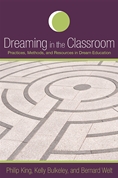 This year I’ve had the honor of serving as an advisor for three doctoral dissertations in the study of dreams. Dianne Jackie Frost at Pacifica Graduate Institute, Cynthia S. Sauln at Sofia University, and Mary Walsh at San Francisco Theological Seminary have done highly innovative work in exploring some of the most important and potentially transformative aspects of dreaming experience. Each of them has shown amazing devotion and diligence, and their findings are truly original contributions to the field.
This year I’ve had the honor of serving as an advisor for three doctoral dissertations in the study of dreams. Dianne Jackie Frost at Pacifica Graduate Institute, Cynthia S. Sauln at Sofia University, and Mary Walsh at San Francisco Theological Seminary have done highly innovative work in exploring some of the most important and potentially transformative aspects of dreaming experience. Each of them has shown amazing devotion and diligence, and their findings are truly original contributions to the field.
Dianne Frost’s dissertation for her Ph.D. in Depth Psychology is titled “Engaging With the Imaginal: A Study of Women’s Dreamwork.” Her study focuses on six women at a counseling center who participated in a group process of sharing dreams, exploring their images, and following their changes over a seven-week period (using methods drawn from the works of Steven Aizenstat, Jack Zimmerman, Virginia Coyle, Mary Watkins, and others). Each of the women came to the process from a place of pain and crisis (interpersonal violence, depression, addiction, body image issues, etc.), and Frost shows how their dreams accurately reflect their emotional concerns and give witness to their suffering. More importantly for therapeutic purposes, the dreams point the way towards healing, towards potentials for new life and new growth beyond the challenging conditions of the present. As the women shared their dreams and discussed possible dimensions of meaning, Frost found they developed a new depth of trust in their own strength, resilience, and creativity.
My favorite quote comes from the woman using the pseudonym “Cadence.” Cadence told Frost she had always looked to outside sources for guidance and advice in her life, but the insights she was gaining from her dreams made her realize she has a reliable source within herself:
“I felt like I needed someone else to guide me through, and this process really allows me to do that on my own. It’s like I’m my own innate healer, with knowledge and images that only I can tap into and create a relationship with and learn from.”
Nothing in Frost’s approach limits it to women with these kinds of problems; her way of working with dreams could be usefully applied with many other groups of people who are striving for greater health and wholeness.
“In My Dreams I Am the Hero I Wish to Be: A Mixed Methods Study of Children’s Dreams, Meaning-Making, and Spiritual Awareness” is the title of Cynthia Sauln’s dissertation for her Ph.D. in Clinical Psychology at Sofia University (formerly the Institute of Transpersonal Psychology). Sauln recruited 32 children between the ages of 6 and 12 who were willing, with their parents’ permission, to describe a vivid or unusual dream. She invited the children to draw pictures of their dreams, and she asked them to fill out two surveys designed to assess their spiritual and religious beliefs. Sauln says in her introduction,
“For the purpose of this study, children’s spirituality is defined as an awareness of the divine or something larger than themselves that can provide meaning for waking life events and understanding of the world around them. Especially for children, it is a personal experience that may be expressed as a ‘knowing’ and an interpretation of the mysteries found in nature, animals, relationships and connections with people, dreams, and/or in their religious practices and beliefs.”
Drawing on the work of Kate Adams, C.G. Jung, and others, Sauln argues that dreams can play a vital role in children’s spiritual development. She shows the close connection between spirituality, health, and creativity in childhood, with dreams as a mode of experience bringing them all together. Ironically, many teachers and parents were so skeptical about dreams in general that they would not give their children permission to participate in Sauln’s study, even though the children themselves were invariably curious about their dreams and eager to discuss and draw pictures of them. This made the data-gathering process much more difficult than Sauln expected.
However, there was a silver lining to these difficulties. Her extra efforts to recruit participants led her to ultimately gather a group of children with an unusual degree of ethnic diversity. There were several Hispanic children in her study whose dreams seemed especially significant in relation to their waking spiritual beliefs. In my SDDb research I’ve found some evidence of relatively high Hispanic interest in spiritually meaningful dreams. I wonder if future research from Sauln or others might explore Hispanic dream experiences in more detail.
Mary Walsh’s dissertation for her Doctor of Ministry in Advanced Pastoral Studies from San Francisco Theological Seminary is titled “Prophetic Imagination and the Neuro-physiology of Trauma in Substance Abusing Adolescents.” Walsh is a practicing psychotherapist whose doctoral studies have examined the theological dimensions of suffering, caregiving, and healing. For two years she worked as a therapist at a high school for troubled adolescents, with a focus on their dreams in relation to several other measures of mental and physical health. The students at her school came from extremely disadvantaged backgrounds, and many of them were suffering multiple symptoms of post-traumatic stress disorder (PTSD). In addition to talking about their dreams, she measured the students’ heart rate variability to track their neuro-physiological coherence during the treatment process. Walsh’s use of sophisticated biofeedback technology will make it possible to illuminate new dimensions of dreaming and its role in mind-body healing. I’m very curious to see what further uses can be made of biofeedback technologies like these.
Walsh has gathered an extremely valuable set of data that provides unique insights into the life experiences of young people at the most neglected margins of society. Although she still has some writing to do, her project is putting together a compelling argument in favor of the therapeutic effectiveness of group dreamsharing for this poorly-served population.
It should be obvious I’m very proud of these three researchers! Each of them has stayed true to her original vision and persevered in her scholarly work despite all manner of obstacles and static from uncomprehending administrators, teachers, etc. Their success bodes well for the future of dream studies.




